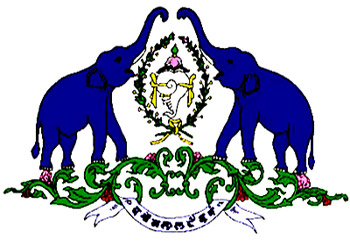 Kulasekhara dynasty ruled the whole of modern state of Kerala, Guddalore and some parts of Nilgiri district and Salem - Coimbatore region between 9th and 12th centuries AD. Their ancestry can be traced back to the powerful Chera dynasty of the Tamil Sangam Age. The age of Kulasekharas of Mahodayapuram is considered as the Golden Age of Kerala.
Kulasekhara dynasty ruled the whole of modern state of Kerala, Guddalore and some parts of Nilgiri district and Salem - Coimbatore region between 9th and 12th centuries AD. Their ancestry can be traced back to the powerful Chera dynasty of the Tamil Sangam Age. The age of Kulasekharas of Mahodayapuram is considered as the Golden Age of Kerala.
After the disappearance of the Kalabhras rule in south India the Chera dynasty was revived around 9th century as Kulasekharas had come from Kodungallur. The Kulasekharas were from the Villavar martial clan and the Chera king had the title Villavar Kon. The Later Cheras had a second capital at Udagai in the Kongunad. They shared the present state of Kerala with the Mushikas in the north and the Ays in the south and other Chieftains ruling small regions of rest of the region. They were in continuous war with the neighbouring Chola dynasty and the Rashtrakuta Empire. Rama Varma Kulashekhara the last of the Kulasekharas and the first Kulasekhara Venad ruler moved his capital to a provincial capital Kollam when Later Chola king Kulothunga Chola I sacked Mahodyapuram. The death of Rama Varma Kulashekhara ended the rule of Mahodayapuram Cheras and from the ruins of which arose the Kulasekhara state of Venad and leading to the kingdom of Travancore.
Hinduism made phenomenal progress during this rule. Malayalam language developed during this period. This age also witnessed a development of various cultural activities. New festivals were celebrated among which Onam was the most important.
Kulasehkhara dynasty was named after founder and devotional Vaishnavite poet and one of the 12 Alvars, Kulashekhara Varman. The initial territories included Kudamalainadu only. Kulashekhara Varman re-united Kerala into a united homogeneous and ruled from the capital city of Mahodayapuram that was built around the Siva temple of Tiruvanchikulam. He also called himself as Kongarkon hailing from Kollinagar. This title indicates that Kulashekhara Varman had regained control of Kongu from the Western Ganga Dynasty in his reign. He died in 820 AD.
Rama rajasekhara varman
The second and fourth Kulasehara kings Rajashekhara Varman and Varma Kulashekhara leaded Hindu religious movements as celebrated Shaivite and Vaishnavite saints respectively. Rajashekhara Varman was the next king who succeeded Mahodayapuram Cheras. He was an ardent follower of Lord Siva. It was during his reign the Kollavarsham had begun. His kingdom included ruled the regions of Kuttanadu, Venadu and Tenpandinadu. He spent most of his time in religious activities. He also composed many hyms in Tamil in praise of Lord Shiva.
He was succeeded by his son Sthanu Ravi Varman. Sthanu Ravi Varman was also a Shaivite like his father.
Rama Varma Kulashekhara
Rama Varma Kulashekhara was the last king of this dynasty. He ascended the throne when the state was going through a period of severe crisis. Kulottunga Chola I had occupied Nanjanad and south Kerala and destroyed the capital city of Mahodayapuram.
The kings of Kulasekhara dynasty
Kulashekhara Varman (800-820 AD)
Rajashekhara Varman (820-844 AD)
Sthanu Ravi Varman (844-885 AD)
Rama Varma Kulashekhara (885-917 AD)
Goda Ravi Varma (917-944 AD)
Indu Kotha Varma (944-962 AD)
Bhaskara Ravi Varman I (962-1019 AD)
Bhaskara Ravi Varman II (1019-1021 AD)
Vira Kerala (1021-1028 AD)
Rajasimha (1028-1043 AD)
Bhaskara Ravi Varman III (1043-1082 AD)
Ravi Rama Varma (1082-1090 AD)
Rama Varma Kulashekhara (1090-1102 AD)



















